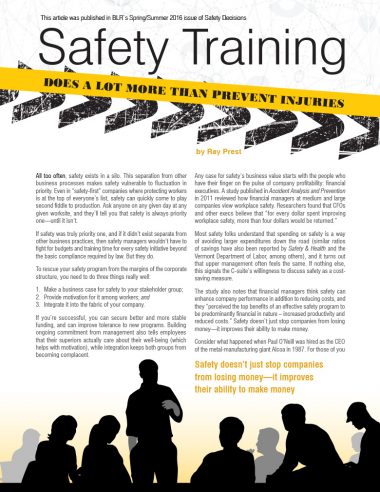This article by Ray Prest was published in
BLR’s Spring/Summer 2016 issue of Safety Decisions
All too often, safety exists in a silo. This separation from other business processes makes safety vulnerable to fluctuation in priority. Even in “safety-first” companies where protecting workers is at the top of everyone’s list, safety can quickly come to play second fiddle to production. Ask anyone on any given day at any given worksite, and they’ll tell you that safety is always priority one—until it isn’t.
If safety was truly priority one, and if it didn’t exist separate from other business practices, then safety managers wouldn’t have to fight for budgets and training time for every safety initiative beyond the basic compliance required by law. But they do.
To rescue your safety program from the margins of the corporate structure, you need to do three things really well:
- Make a business case for safety to your stakeholder group;
- Provide motivation for it among workers; and
- Integrate it into the fabric of your company.
If you’re successful, you can secure better and more stable funding, and can improve tolerance to new programs. Building ongoing commitment from management also tells employees that their superiors actually care about their well-being (which helps with motivation), while integration keeps both groups from becoming complacent.
Any case for safety’s business value starts with the people who have their finger on the pulse of company profitability: financial executives. A study published in Accident Analysis and Prevention in 2011 reviewed how financial managers at medium and large companies view workplace safety. Researchers found that CFOs and other execs believe that “for every dollar spent improving workplace safety, more than four dollars would be returned.”
Most safety folks understand that spending on safety is a way of avoiding larger expenditures down the road (similar ratios of savings have also been reported by Safety & Health and the Vermont Department of Labor, among others), and it turns out that upper management often feels the same. If nothing else, this signals the C-suite’s willingness to discuss safety as a cost-saving measure.
The study also notes that financial managers think safety can enhance company performance in addition to reducing costs, and they “perceived the top benefits of an effective safety program to be predominantly financial in nature – increased productivity and reduced costs.” Safety doesn’t just stop companies from losing money—it improves their ability to make money.
Safety doesn’t just stop companies from losing money—it improves their ability to make money
Consider what happened when Paul O’Neill was hired as the CEO of the metal-manufacturing giant Alcoa in 1987. For those of you who don’t know the story, the first thing O’Neill did at the helm of the Pittsburgh-based company was make safety a priority. He obsessively sought out safety improvements and hounded upper management about the safety performance of their subordinates. The end result is that after 13 years Alcoa’s market capitalization increased by $27 billion.
No single factor is ever responsible for such a drastic improvement, but O’Neill readily attributes the company’s improved performance to changes in safety. (You can find more details of O’Neill’s amazing story in The Power of Habit by Charles Duhigg.)
If you think that O’Neill’s story is a unique case or that Alcoa’s enormous resources allowed it to take advantage where smaller companies couldn’t, consider Plymouth Tube’s 49-employee steel mill in Streator, Illinois. Kyle Roach, the mill’s operations manager, recently discussed how an increased focus on safety has provided a tangible financial benefit. He noted that productivity and yield both increased, and customer complaints decreased, as a by-product of safety improvements. Like O’Neill, he discovered that safety is a gateway to overall culture change.
The business case for safety shouldn’t stop with the executive management. Behavioral safety training offers plant and quality managers an additional level of performance as well. Once you teach people how to pay attention to risk and adjust their actions to avoid the errors that can get them hurt, you can translate those skills and habits into the production environment with fewer performance errors. It can also provide essential motivation for workers.
In many companies, safety is one of the few areas of common ground between workers and management. Typical performance indicators that motivate managers include profit margins, scrap waste ratio and the like. How often do you think your employees stay up at night worrying about these things?
What they do care about is safety. If you asked for volunteers to take extra safety training you wouldn’t see any hands in the air since they think they’re safe enough already. But beneath their over-confidence with safety procedures there is genuine concern for their quality of life outside of work and their ability to go home safely to their families and the activities they enjoy. Focusing on off-the-job safety and your worker’s personal agenda will
build motivation.Hopefully, this knowledge will provide safety professionals with ammunition the next time they need to fight for a larger safety budget—it can make it easier to point out that marginalizing safety means leaving money on the table. It shows that an investment in safety training is also an investment in productivity.
There’s one final component of making a business case for safety—and it’s also the most frequently overlooked. The only way to sustain the financial benefits of safety is to integrate your safety initiatives with the rest of your business. Incorporate safety into everyday functions with continuous improvements, ongoing initiatives and an annual budget. Build it into production processes, build it into new employee training, build it into reports. Help it become the common language that everyone uses from the boardroom to the shop floor. Create an ongoing, meaningful and barrier-free dialog that translates across all arenas, from safety and production to employees and management, both at work and at home.
It’s a big task, but the business will be better for it. A study published this January with the intriguing title “Tracking the Market Performance of Companies That Integrate a Culture of Health and Safety: An Assessment of Corporate Health Achievement Award Applicants” suggests that financial performance may be associated with safety achievement. Researchers investigated the stock market performance of 31 companies that were known for adopting high safety standards throughout their organization. They found that from 2001-2014, the companies’ stocks performed better than the S&P average in all 17 measures under examination.
It’s clear that safety and productivity are inextricably linked. You can fully leverage the value of safety by integrating it into your company’s processes. Use it as a source of motivation and employee engagement, and demonstrate to upper management that spending on safety initiatives leads to healthy employees and a healthy bottom line. Your staff—and shareholders—will appreciate it.
Ray Prest is the Director of Marketing at SafeStart, a safety company focused on human factors solutions that reduce preventable death and injuries on and off the job. A columnist for Safety Decisions since 2015, Ray’s been helping people learn about safety and training for over 20 years. Read more at safestart.com/ray.

Get the PDF version
You can download a printable PDF of the article using the button below.

